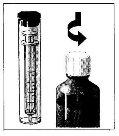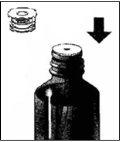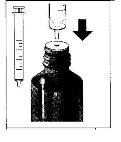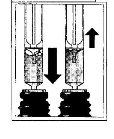
РИВАСТИГМІН АБАБОР 2 мг/мл ОРАЛЬНИЙ РОЗЧИН

Інструкція із застосування РИВАСТИГМІН АБАБОР 2 мг/мл ОРАЛЬНИЙ РОЗЧИН
Введення
Огляд: інформація для користувача
Ривастигміна Абабор 2 мг/мл оральний розчин ЕФГ
Прочитайте уважно весь листок перед тим, як почнете приймати цей препарат, оскільки він містить важливу інформацію для вас
- Збережіть цей листок, оскільки вам може знадобитися знову його прочитати.
- Якщо у вас виникли питання, проконсультуйтеся з вашим лікарем, фармацевтом або медсестрою.
- Цей препарат призначений лише для вас, і не давайте його іншим людям, навіть якщо вони мають такі самі симптоми, як у вас, оскільки це може їм нашкодити.
- Якщо ви відчуваєте побічні ефекти, проконсультуйтеся з вашим лікарем, фармацевтом або медсестрою, навіть якщо це побічні ефекти, які не перераховані в цьому листку. Див. розділ 4.
Зміст листка
- Що таке Ривастигміна Абабор і для чого він використовується
2 Що потрібно знати перед тим, як почати приймати Ривастигміну Абабор
- Як приймати Ривастигміну Абабор
- Можливі побічні ефекти
- Збереження Ривастигміни Абабор
- Зміст і додаткова інформація
1. Що таке Ривастигміна Абабор і для чого він використовується
Активний інгредієнт - Ривастигміна.
Ривастигміна належить до групи речовин, званих інгібіторами холінестерази.
У пацієнтів з деменцією Альцгеймера або деменцією, викликаною хворобою Паркінсона, певні нервові клітини гинуть у мозку, що призводить до низьких рівнів нейротрансмітера ацетилхоліну (речовини, яка дозволяє нервовим клітинам спілкуватися між собою). Ривастигміна діє шляхом блокування ферментів, які розкладають ацетилхолін: ацетилхолінестеразу та бутирилхолінестеразу. Блокуючи ці ферменти, ривастигміна дозволяє збільшити рівні ацетилхоліну в мозку, що допомагає зменшити симптоми хвороби Альцгеймера та деменції, пов'язаної з хворобою Паркінсона.
Ривастигміна Абабор використовується для лікування пацієнтів з деменцією Альцгеймера легкого до середнього ступеня важкості, прогресивного захворювання мозку, яке поступово впливає на пам'ять, інтелектуальні здібності та поведінку. Також він може використовуватися для лікування деменції у пацієнтів з хворобою Паркінсона.
2. Що потрібно знати перед тим, як приймати Ривастигміну Абабор
Не приймайте Ривастигміну Абабор
- якщо ви алергічні на ривастигміну або на будь-який інший компонент цього препарату (перелічені в розділі 6).
Якщо це відбувається, повідоміть про це вашому лікареві і припиніть приймати Ривастигміну Абабор
Попередження та застереження
Проконсультуйтеся з вашим лікарем перед тим, як почати приймати Ривастигміну Абабор.
- якщо у вас є або був раніше нерегулярний чи повільний серцевий ритм
- якщо у вас є або був раніше активна виразка шлунка
- якщо у вас є або був раніше труднощі з сечовипусканням
- якщо у вас є або був раніше епілептичні припадки (припадки чи конвульсії)
- якщо у вас є або був раніше бронхіальна астма чи важке захворювання дихальної системи
- якщо у вас є або був раніше порушення функції нирок
- якщо у вас є або був раніше порушення функції печінки
- якщо у вас є тремор
- якщо у вас низька маса тіла
- якщо ви відчуваєте шлунково-кишкові реакції, такі як нудота, блювота та діарея. Ви можете втратити багато рідини, якщо блювота чи діарея тривають тривалий час
Якщо ви знаходитесь в одній з цих ситуацій, ваш лікар може вважати необхідним проводити більш ретельний моніторинг під час лікування.
Якщо ви забули прийняти Ривастигміну Абабор протягом більш ніж трьох днів, не приймайте наступну дозу до тих пір, поки не проконсультуєтеся з вашим лікарем.
Діти та підлітки
Немає жодного значення використання Ривастигміни Абабор у педіатричній популяції для лікування хвороби Альцгеймера.
Використання Ривастигміни Абабор з іншими препаратами
Повідоміть вашому лікареві або фармацевту, якщо ви використовуєте, нещодавно використовували або можете використовувати будь-який інший препарат.
Ривастигміна не повинна прийматися одночасно з іншими препаратами, які мають подібні ефекти. Ривастигміна може взаємодіяти з антихолінергічними препаратами (препаратами, які використовуються для полегшення шлунково-кишкових спазмів, лікування хвороби Паркінсона чи профілактики морської хвороби).
Ривастигміна Абабор не повинна прийматися одночасно з метоклопрамідом (препаратом, який використовується для полегшення чи профілактики нудоти та блювоти). Прийом обидвох препаратів одночасно може викликати проблеми, такі як жорсткість кінцівок та тремор рук.
У разі проведення хірургічної операції під час прийому ривастигміни повідоміть вашому лікареві перед тим, як буде проведено анестезія, оскільки ривастигміна може посилити ефекти деяких м'язових релаксантів під час анестезії.
Потрібно бути обережним при прийомі ривастигміни разом з бета-блокаторами (препаратами, такими як атенолол, які використовуються для лікування гіпертонії, ангіни та інших захворювань серця). Прийом обидвох препаратів одночасно може викликати проблеми, такі як зниження частоти серцевих скорочень (брадикардія), що може призвести до втрати свідомості.
Вагітність, лактація та фертильність
Якщо ви вагітні або годуєте грудьми, чи вважаєте, що можете бути вагітною чи маєте намір завагітніти, проконсультуйтеся з вашим лікарем перед тим, як приймати цей препарат.
Якщо ви вагітні, необхідно оцінити користь від використання Ривастигміни Абабор порівняно з можливими побічними ефектами для плода.
Відповідно до наявних даних, використання Ривастигміни Абабор під час вагітності не рекомендується, якщо це не абсолютно необхідно. Повідоміть вашому лікареві, якщо ви завагітніте під час лікування.
Жінки, які приймають Ривастигміну Абабор, не повинні годувати грудьми.
Водіння автомобіля та використання машин
Ваше захворювання може вплинути на вашу здатність водити автомобіль чи використовувати машини, і ви не повинні виконувати ці дії, якщо ваш лікар не вважає це безпечним.
Ривастигміна Абабор може викликати головокружіння та сонливість, особливо на початку лікування чи при збільшенні дози. Якщо ви відчуваєте ці ефекти, не повинні водити автомобіль, використовувати машини чи виконувати завдання, які вимагають вашої уваги.
Важлива інформація про деякі компоненти Ривастигміни Абабор 2 мг/мл оральної розважки
Одним з допоміжних речовин у Ривастигміні Абабор оральній розважці є бензоат натрію. Цей препарат може бути подразливим для шкіри, очей та слизових оболонок, оскільки містить бензойну кислоту.
Ривастигміна Абабор також містить 1,867 мг натрію на мл розважки, що повинно бути враховано при лікуванні пацієнтів з дієтою з низьким вмістом натрію.
3. Як приймати Ривастигміну Абабор
Слідуйте точно інструкціям щодо прийому цього препарату, вказаним вашим лікарем. У разі сумнівів проконсультуйтеся з вашим лікарем знову.
Як почати лікування
Ваш лікар призначить вам дозу Ривастигміни.
? Лікування зазвичай починається з низької дози
? Ваш лікар поступово збільшуватиме дозу залежно від того, як ви реагуєте на лікування
? Максимальна доза, яку слід приймати, становить 6 мг двічі на день
Ваш лікар періодично буде оцінювати, чи має місце бажаний ефект. Ваш лікар також буде контролювати вашу масу тіла під час лікування.
Якщо ви не приймали Ривастигміну протягом більш ніж трьох днів, не приймайте наступну дозу до тих пір, поки не проконсультуєтеся з вашим лікарем.
Прийом цього препарату
? Повідоміть вашому опікунові, що ви приймаєте Ривастигміну Абабор.
? Для того щоб ваш препарат мав бажаний ефект, ви повинні приймати його щодня
? Ривастигміна Абабор повинна прийматися двічі на день під час їжі (вранці та ввечері)
Як приймати цей препарат

- Підготуйте флакон та шприц:
? Витягніть шприц з його захисної оболонки
? Натисніть та поверніть кришку безпеки для дітей, щоб відкрити флакон.
- Вставте адаптер шприца в отвір кришки

3 . Вставте шприц в адаптер
 ?
?
? Вставте голку шприца в отвір затикки.
- Наповніть шприц
? Потягніть поршень шприца, поки рідина не досягне маркування дози, призначеної вашим лікарем

- Видаліть бульбашки
? Видаліть великі бульбашки за допомогою чергових рухів поршня.
? Дві-три маленькі бульбашки не мають значення і не впливають на дозу жодним чином.
? Перевірте, чи правильна доза
? Надалі витягніть шприц з флакона.

- Прийом препарату
? Прийом дози безпосередньо з шприца.
? Ви також можете змішати його з водою в маленькому склянці. Перемішайте та випийте суміш повністю.
- Після використання шприца
? Очистіть зовнішню частину шприца та адаптера чистим рушником.
? Надалі поверніть шприц в його захисну оболонку.
? Закрійте флакон кришкою безпеки для дітей.
Якщо ви прийняли більше Ривастигміни Абабор, ніж потрібно
У разі передозування або випадкового прийому препарату проконсультуйтеся з вашим лікарем, фармацевтом або телефонуйте в Токсикологічну службу, телефон 91 562 04 20, вказуючи препарат та кількість, прийняту.
Деякі люди, які випадково прийняли більшу дозу, відчували нудоту, блювоту, діарею, підвищення артеріального тиску та галюцинації. Можливо також сповільнення частоти серцевих скорочень та втрати свідомості.
Якщо ви забули прийняти Ривастигміну Абабор
Якщо ви забули свою дозу ривастигміни Абабор, чекайте та прийміть наступну дозу в звичайний час. Не приймайте подвійну дозу, щоб компенсувати забуту дозу.
Якщо у вас є будь-які інші питання щодо використання цього препарату, проконсультуйтеся з вашим лікарем або фармацевтом.
4. Можливі побічні ефекти
Як і всі препарати, цей препарат може викликати побічні ефекти, хоча не всі люди їх відчувають.
Частота появи побічних ефектів є більшою при початку прийому препарату або при збільшенні дози. Побічні ефекти зазвичай зникають поступово, коли ваш організм звикає до препарату.
Дуже часті:(можуть впливати на більше 1 з 10 осіб)
- Головокружіння
- Втрата апетиту
- Шлунково-кишкові проблеми, такі як нудота, блювота, діарея
Часті:(можуть впливати до 1 з 10 осіб)
- Тревога
- Потіння
- Головний біль
- Паління
- Втрата ваги
- Біль у шлунку
- Агітація
- Чуття втоми чи слабкості
- Загальне нездоров'я
- Тремор чи чуття плутані
- Зменшення апетиту
- Кошмари
Нечасті:(можуть впливати до 1 з 100 осіб)
- Депресія
- Труднощі зі сном
- Втрати свідомості чи випадкові падіння
- Зміни функції печінки
Рідкісні:(можуть впливати до 1 з 1000 осіб)
- Біль у грудній клітці
- Шкірна висипка
- Епілептичні припадки (припадки чи конвульсії)
- Шлунково-кишкові виразки
Дуже рідкісні:(можуть впливати до 1 з 10000 осіб)
- Високий артеріальний тиск
- Інфекції сечовивідних шляхів
- Галюцинації
- Проблеми з ритмом серця (швидка чи повільна частота серцевих скорочень)
- Шлунково-кишкові кровотечі (кров у фекаліях чи блювоті)
- Запалення підшлункової залози (сильний біль у верхній частині шлунка, часто супроводжується нудотою та блювотою)
Частота невідома:(не може бути оцінена на основі наявних даних)
- Тяжкі блювоти, які можуть призвести до розриву стравоходу (частини травного тракту, яка сполучає рот з шлунком)
Пацієнти з деменцією, пов'язаною з хворобою Паркінсона
Ці пацієнти відчувають деякі побічні ефекти частіше, а також додаткові побічні ефекти:
Дуже часті:(можуть впливати на більше 1 з 10 осіб)
- Тремор
- Втрати свідомості
- Випадкові падіння
Часті:(можуть впливати до 1 з 10 осіб)
- Тревога
- Неспокій
- Швидка чи повільна частота серцевих скорочень
- Труднощі зі сном
- Надмірна слина та дефіцит рідини
- Нормально-повільні чи неконтрольовані рухи
- Погіршення хвороби Паркінсона чи розвиток подібних симптомів (м'язова ригідність, труднощі з рухами та м'язова слабкість)
Нечасті:(можуть впливати до 1 з 100 осіб)
- Нерегулярна чи повільна частота серцевих скорочень та порушення контролю рухів
Частота невідома:(не може бути оцінена на основі наявних даних)
- Синдром Піза (захворювання, яке супроводжується мимовільним скороченням м'язів та аномальним нахилом тіла та голови в бік)
Відзначені наступні додаткові побічні ефекти при використанні трансдермальних пластерів Ривастигміни, які можуть виникнути при прийомі оральної розважки:
Часті:
- Гарячка
- Тяжка плутаність
- Неможливість утримувати сечу (неможливість правильно сечовипускати)
Нечасті:(можуть впливати до 1 з 100 осіб)
- Гіперактивність (підвищений рівень активності, неспокій)
Частота невідома:(не може бути оцінена на основі наявних даних)
Алергічна реакція в місці застосування пластиру, така як пухирці чи запалення шкіри.
Якщо ви відчуваєте ці симптоми, проконсультуйтеся з вашим лікарем, оскільки може знадобитися медична допомога.
Сповіщення про побічні ефекти
Якщо ви відчуваєте будь-які побічні ефекти, проконсультуйтеся з вашим лікарем або фармацевтом, навіть якщо це можливі побічні ефекти, які не перераховані в цьому листку. Ви також можете повідомити про них безпосередньо через Іспанську систему фармакологічного нагляду за лікарськими засобами для людини: https://notificaram.es Надсилаючи повідомлення про побічні ефекти, ви можете допомогти надати більше інформації про безпеку цього препарату.
5. Збереження Ривастигміни Абабор
Тримайте цей препарат поза досяжністю дітей.
Не використовуйте цей препарат після закінчення терміну його дії, вказаного на упаковці після CAD. Термін дії препарату - останній день місяця, який вказано.
Не зберігайте в холодильнику.
Тримайте упаковку в вертикальному положенні.
Використовуйте Ривастигміну Абабор 2 мг/мл оральну розважку протягом місяця після першого відкриття флакона.
Лікарські засоби не повинні викидатися в каналізацію чи сміття. Відкладайте упаковку та лікарські засоби, які вам не потрібні, в пункті збору SIGRE аптеки. У разі сумнівів проконсультуйтеся з вашим фармацевтом, як позбутися упаковки та лікарських засобів, які вам не потрібні. Таким чином, ви допоможете захистити довкілля.
6. Зміст упаковки та додаткова інформація
- Активний інгредієнт - гідрогенотартрат ривастигміни, еквівалентний 2,0 мг ривастигміни.
- Допоміжні речовини: бензоат натрію (Е211), цитринова кислота моногідрат (Е330), цитрат натрію (Е331), жовтий квінолін, розчинний у воді (Е104), очищена вода.
Вигляд продукту та зміст упаковки
Ривастигміна Абабор 2 мг/мл оральна розважка випускається у вигляді прозорої, жовтої розважки (2,0 мг/мл ривастигміни) об'ємом 50 або 120 мл у флаконах з коричневого скла типу III з кришкою безпеки для дітей. Разом з оральною розважкою надходить шприц для дозування та адаптер для шприца в пластиковій трубці.
Власник дозволу на розповсюдження
Ababor Pharmaceuticals, S.L.
Чилі, 4 - Будівля 1 - Офіс 1 - Лас Матас
28290- Лас Розас. Іспанія
Виробник
Pharmanel Pharmaceuticals SA
60-й км від Афін - Ламії шосе,
GR 320 09
Греція
І
Pharmathen SA
Дервенакіон 6
Палліні 15351
Аттика, Греція
Цей листок був затверджений у вересні 2015 року
Дата останньої ревізії цього листка: січень 2025 року
Детальна та актуальна інформація про цей препарат доступна на сайті Іспанського агентства лікарських засобів та медичних продуктів (AEMPS)http://www.aemps.gob.es
- Країна реєстрації
- Діючі речовини
- Потрібен рецептТак
- Виробник
- СкладBENZOATO DE SODIO (E 211) (1.0 mg mg), CITRATO DE SODIO (E-331) (7.2756 mg mg)
- Інформація є довідковою і не є медичною порадою. Перед прийомом будь-яких препаратів обов'язково проконсультуйтеся з лікарем. Oladoctor не несе відповідальності за медичні рішення, прийняті на основі цього контенту.
- Альтернативи до РИВАСТИГМІН АБАБОР 2 мг/мл ОРАЛЬНИЙ РОЗЧИНФорма випуску: ТРАНСДЕРМАЛЬНИЙ ПЛАСТИР, 13,3 мг/24 годДіючі речовини: rivastigmineВиробник: Esteve Pharmaceuticals S.A.Потрібен рецептФорма випуску: ТРАНСДЕРМАЛЬНИЙ ПЛАСТИР, 4,6 мг/24 годДіючі речовини: rivastigmineВиробник: Esteve Pharmaceuticals S.A.Потрібен рецептФорма випуску: ТРАНСДЕРМАЛЬНИЙ ПЛАСТИР, 9,5 мг/24 годДіючі речовини: rivastigmineВиробник: Esteve Pharmaceuticals S.A.Потрібен рецепт




